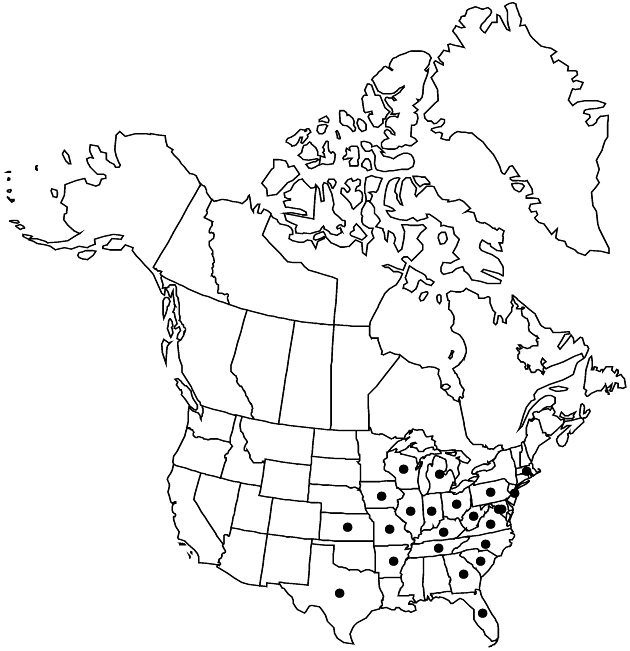Difference between revisions of "Helianthus occidentalis"
W. J. Med. Phys. Sci. 9: 577. 1836.
FNA>Volume Importer |
imported>Volume Importer |
||
| Line 8: | Line 8: | ||
}} | }} | ||
|common_names=Western sunflower | |common_names=Western sunflower | ||
| + | |special_status={{Treatment/ID/Special_status | ||
| + | |code=E | ||
| + | |label=Endemic | ||
| + | }} | ||
|basionyms= | |basionyms= | ||
|synonyms= | |synonyms= | ||
| Line 20: | Line 24: | ||
-->{{Treatment/Body | -->{{Treatment/Body | ||
| − | |distribution= | + | |distribution=Ark.;D.C.;Fla.;Ga.;Ill.;Ind.;Iowa;Kans.;Ky.;Mass.;Md.;Mich.;Mo.;N.C.;N.J.;Ohio;Pa.;S.C.;Tenn.;Tex.;Va.;W.Va.;Wis. |
|discussion=<p>Subspecies 2 (2 in the flora).</p> | |discussion=<p>Subspecies 2 (2 in the flora).</p> | ||
|tables= | |tables= | ||
| Line 50: | Line 54: | ||
|basionyms= | |basionyms= | ||
|family=Asteraceae | |family=Asteraceae | ||
| − | |distribution= | + | |distribution=Ark.;D.C.;Fla.;Ga.;Ill.;Ind.;Iowa;Kans.;Ky.;Mass.;Md.;Mich.;Mo.;N.C.;N.J.;Ohio;Pa.;S.C.;Tenn.;Tex.;Va.;W.Va.;Wis. |
|reference=None | |reference=None | ||
|publication title=W. J. Med. Phys. Sci. | |publication title=W. J. Med. Phys. Sci. | ||
|publication year=1836 | |publication year=1836 | ||
| − | |special status= | + | |special status=Endemic |
| − | |source xml=https:// | + | |source xml=https://bibilujan@bitbucket.org/aafc-mbb/fna-data-curation.git/src/bb6b7e3a7de7d3b7888a1ad48c7fd8f5c722d8d6/coarse_grained_fna_xml/V19-20-21/V21_382.xml |
|tribe=Asteraceae tribe Heliantheae | |tribe=Asteraceae tribe Heliantheae | ||
|subtribe=Asteraceae (tribe Heliantheae) subtribe Helianthinae | |subtribe=Asteraceae (tribe Heliantheae) subtribe Helianthinae | ||
Revision as of 20:59, 27 May 2020
Perennials, 60–150 cm (rhizomatous, sometimes stoloniferous as well). Stems (often reddish) erect, pilose to appressed-hairy proximally. Leaves mostly basal; opposite; petioles 2.5–10 cm; blades oblong-lanceolate or elliptic to ovate, 5–20 × 1.5–7 cm, bases cuneate, margins entire or serrulate, abaxial faces scabrous to hispidulous, gland-dotted (cauline usually smaller, rarely 2–4 pairs well developed). Heads 1–4(–12). Peduncles 1–14 cm. Involucres cylindric, 9–14 mm diam. Phyllaries 20–25, lanceolate, 4.5–7(–11) × 1.5–2.5 mm, (margins usually ciliate) apices acute to short-acuminate, abaxial faces glabrate to sparsely pilose (hairs moniliform), not gland-dotted. Paleae 5–7 mm, subentire to 3-toothed (shortly mucronate). Ray florets 8–14; laminae 18–22 mm (abaxial faces densely gland-dotted). Disc florets 50+; corollas 4.5–5.5 mm, lobes yellow; anthers dark brown or black, appendages yellow. Cypselae 3–4(–5) mm, sparsely villous or glabrate; pappi of 2 aristate scales 1.5–2.8 mm plus 0–4 deltate scales 0.4–1 mm. 2n = 34 (subspecies unknown).
Distribution

Ark., D.C., Fla., Ga., Ill., Ind., Iowa, Kans., Ky., Mass., Md., Mich., Mo., N.C., N.J., Ohio, Pa., S.C., Tenn., Tex., Va., W.Va., Wis.
Discussion
Subspecies 2 (2 in the flora).
Selected References
None.
Key
| 1 | Leaves entire or nearly so, scabrous or hirsute, rough to touch | Helianthus occidentalis subsp. occidentalis |
| 1 | Leaves usually serrate, strigose or glabrous, smooth to touch | Helianthus occidentalis subsp. plantagineus |